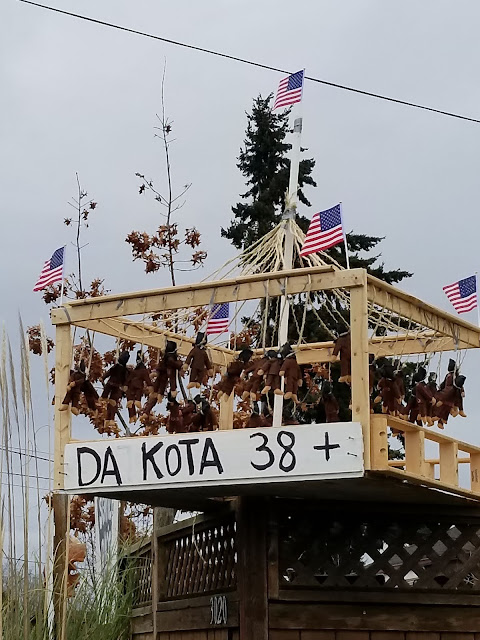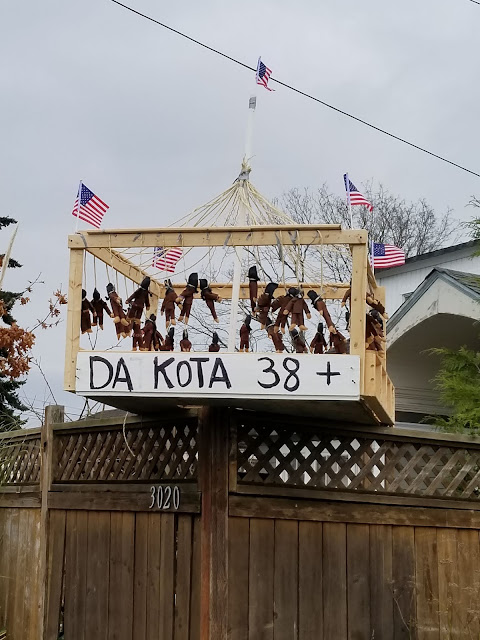 |
| Remembrance of the Dakota 38 above the home of Robert Free in Seattle today. Photos courtesy Robert Free. |
"You have deceived me. You told me that if we followed the advice of General Sibley, and gave ourselves up to the whites, all would be well; no innocent man would be injured. I have not killed, wounded or injured a white man, or any white persons. I have not participated in the plunder of their property; and yet to-day I am set apart for execution, and must die in a few days, while men who are guilty will remain in prison. My wife is your daughter, my children are your grandchildren. I leave them all in your care and under your protection. Do not let them suffer; and when my children are grown up, let them know that their father died because he followed the advice of his chief, and without having the blood of a white man to answer for to the Great Spirit."
Source: Isaac V. D. Heard, History of the Sioux War and Massacres of 1862 and 1863, NY: Harper & Bros., 1863
Historical accounts:
Carol Chomsky, Associate Professor, University of Minnesota Law School
On September 28, 1862, two days after the surrender at Camp Release, a commission of military officers established by Henry Sibley began trying Dakota men accused of participating in the war. Several weeks later the trials were moved to the Lower Agency, where they were held in one of the only buildings left standing, trader François LaBathe’s summer kitchen.
As weeks passed, cases were handled with increasing speed. On November 5, the commission completed its work. 392 prisoners were tried, 303 were sentenced to death, and 16 were given prison terms.
President Lincoln and government lawyers then reviewed the trial transcripts of all 303 men. As Lincoln would later explain to the U.S. Senate:
"Anxious to not act with so much clemency as to encourage another outbreak on one hand, nor with so much severity as to be real cruelty on the other, I ordered a careful examination of the records of the trials to be made, in view of first ordering the execution of such as had been proved guilty of violating females."
When only two men were found guilty of rape, Lincoln expanded the criteria to include those who had participated in “massacres” of civilians rather than just “battles.” He then made his final decision, and forwarded a list of 39 names to Sibley.
On December 26, 1862, 38 Dakota men were hanged at Mankato.
At 10:00 am on December 26, 38 Dakota prisoners were led to a scaffold specially constructed for their execution. One had been given a reprieve at the last minute. An estimated 4,000 spectators crammed the streets of Mankato and surrounding land. Col. Stephen Miller, charged with keeping the peace in the days leading up to the hangings, had declared martial law and had banned the sale and consumption of alcohol within a ten-mile radius of the town.
As the men took their assigned places on the scaffold, they sang a Dakota song as white muslin coverings were pulled over their faces. Drumbeats signaled the start of the execution. The men grasped each others’ hands. With a single blow from an ax, the rope that held the platform was cut. Capt. William Duley, who had lost several members of his family in the attack on the Lake Shetek settlement, cut the rope.
After dangling from the scaffold for a half-hour, the men’s bodies were cut down and hauled to a shallow mass grave on a sandbar between Mankato’s main street and the Minnesota River. Before morning, most of the bodies had been dug up and taken by physicians for use as medical cadavers.
Following the mass execution on December 26, it was discovered that two men had been mistakenly hanged. Wicaƞḣpi Wastedaƞpi (We-chank-wash-ta-don-pee), who went by the common name of Caske (meaning the first-born son), reportedly stepped forward when the name “Caske” was called, and was then separated for execution from the other prisoners. The other, Wasicuƞ, was a young white man who had been adopted by the Dakota at an early age. Wasicuƞ had been acquitted.
Brown, Dee Alexander. Bury My Heart at Wounded Knee: An Indian History of the American West. New York: Holt, Rinehart & Winston, 1971.
Heard, Isaac V. D. History of the Sioux War and Massacres of 1862 and 1863. New York: Harper & Brothers, 1863.
Meyer, Roy Willard. History of the Santee Sioux; United States Indian Policy on Trial. Lincoln: University of Nebraska, 1993.
Primary
Heard, Isaac V. D. History of the Sioux War and Massacres of 1862 and 1863. New York: Harper & Brothers, 1863.
Isch, John. The Dakota Trials: The 1862-1864 Military Commission Trials : Including the Trial Transcripts and Commentary. New Ulm, MN: Brown County Historical Society, 2012.
Secondary
Brown, Dee Alexander. Bury My Heart at Wounded Knee: An Indian History of the American West. New York: Holt, Rinehart & Winston, 1971.
Chomsky, Carol. The United States-Dakota War Trials: A Study in Military Injustice. Stanford Law Review, November, 1990.
Meyer, Roy Willard. History of the Santee Sioux; United States Indian Policy on Trial. Lincoln: University of Nebraska, 1993.



No comments:
Post a Comment